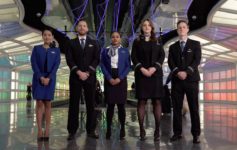United’s Hong Kong routes are performing so poorly the airline is re-evaluating what they are worth.
United Airlines expects to record a non-cash impairment charge of $90 million for the Fourth Quarter in specific regards to its Hong Kong routes. As civil unrest persist and demand weakens, United has scaled back its Hong Kong service, cutting Chicago – Hong Kong and reducing the frequency of its Newark – Hong Kong service.
> Read More:United Scales Back Hong Kong Service
In an 8-K filing with the SEC, United disclosed its Hong Kong routes are simply not worth what they once were:
“For fourth quarter 2019, the company expects to record a special non-cash impairment charge of $90 million associated with its Hong Kong routes.
“The company conducted its annual impairment review of intangible assets in the fourth quarter of 2019, which consisted of a comparison of the book value of specific assets to the fair value of those assets calculated using the discounted cash flow method.
“Due to a decrease in demand for the Hong Kong market and the resulting decrease in unit revenue, the company determined that the value of its Hong Kong routes had been fully impaired. Notwithstanding such impairments, the collateral pledged under the company’s term loan continues to be sufficient to satisfy the loan covenants.”
If United buys an airline or route, it can book an asset for that, called an “intangible asset”. Let’s say it paid $100MN for a route. This can be recorded as an asset for $100MN on day one. But United must assess, at least annually, whether the route is still “worth” $100MN. United does this on the basis of the discounted cash flows arising from all future flights on that route(s).
If the the new valuation is less than what the asset is recorded at, the difference is written off as an impairment charge.
This is not something United has to write a check for, but does effect the value (perceived and real) of the company. The impairment charge also does not necessarily have a tax implication, but will lower net profits.
CONCLUSION
United is continuing to struggle on its Hong Kong routes. The fourth quarter non-cash impairment charge is a fancy way of saying it no longer values its Hong Kong slots like it used to. More so for the sake of the people of Hong Kong than the airlines that serve it, hopefully stability will return to Hong Kong in 2020.
image: Phillip Capper / Wikimedia Commons





the expense on the P&L goes up (debit) and the asset on the BS goes down (credit). you don’t say the bottomline (net income) goes down because that’s just always the case with added expense.
I am not following the point you are trying to make. Yes, debiting the P&L decreases earnings — while that may seem trivial from a purely accounting perspective, EBT and EPS are certainly important indicators to the investing public.
Matthew improved his wording related to accounting treatment subsequent to my comment
Why United experienced a decrease in demand of Hong Kong route? Civil unrest is only one of the many factors. First, let’s compare apple to apple. Both UA and CX offer nonstop flights EWR – HKG, and SFO – HKG. The service, the food, the equipment, the fare.. CX is better than UA in all of those. Second, many Asians fly these routes to go to their country. UA flight from EWR would arrive around 8pm (the one from SFO is not any better), and no Star partners/non-Star partners to connect to Ho Chi Minh City, Manila,.. until the next day. CX on the other hand, arrives with better time and CX/Dragon is always ready to bring pax to the next destination. Third, the lounge. Unless you fly Polaris, UA lounges in EWR/SFO are the worst. One of the UA lounges in EWR does not even have toilets, small space, crowded, the food.. it is just terrible. Last but not least, UA did “more for customers” by increasing the $ requirement to qualify for 1K/Platinum/Gold, and furthermore, UA rewarded pax with “dynamic award pricing”.
With all of those, and UA expected to make huge profit for this market? Really.
Completely agree. I’ve flown CX a few times but being in Houston I prefer Star Alliance carriers. I do a lot of business in Asia (Taiwan mostly and less so in HKG), I fly BR to Taipei often since it offers nonstop from IAH, and when I need to get to HKG, I still fly them with one stop @ TPE. I could fly UA with a stop in SFO or EWR but why? Their product is less than that of BR. Even UA’s new Polaris seat which is definitely an upgrade over their old hard product but still very narrow/tight for 15+ flights. BR (or CX) win easy over UA without question IMO.
Correction: +15 hour* flights
But none of those factors are recent changes. Five years ago you could both have written almost the same posts, especially in terms of service, schedules and lounges. So I think it is fair to say this impairment is related to the civil unrest. My company has an office in Hong Kong, and we’ve still cancelled a number of business trips there in the last 6 months due to the unrest, I’m sure we’re not alone.
Five years ago, 2014, CX started service between EWR – HKG. While the competitor brings better product to consumer, e.g. new A350, UA has not improved anything for that route. They just changed to 777-300 not long ago, but as reader Steve mentioned, UA changed back to the old 777-200 with no Polaris. if UA wants to believe civil unrest was the only factor contributing to their loss for this market, they are entitled to do so. Lastly, the UA club in EWR (right after security) 5 years ago was at least better. Now UA made it a Polaris lounge, and they added a satellite lounge with no restrooms.. I just think when your business fail, you have to look at all angles. Just personal opinion..
Unfortunately – at least for my searches – this hasn’t meant a noticeable deal on fares to HKG in business class with connecting traffic to other Asian cities. And they just downgraded the EWR-HKG to a 772 without true Polaris seating.
Sad! haha
Do the same pilots fly the same route repeatedly? I guess familiarity with the airport has to be a big factor
How much legwork is needed to start a new route to a satellite station? In other words how much flexibility does an airline have to respond to temporary disruptions.
Pilots atleast for UA bud lines based on seniority. So pilots usually stick to the same routes just because that’s what they get or want. UA could go to only 1 flight a day and the only issue with returning to 3 a day is the slots and ground staff in HKG.
I wonder if they even make money flying to mainline China.
And if they are losing so much money flying to Hong Kong why would they have added a 2nd SFO-HKG flight? So silly. They are going up against SQ with excellent service daily and CX with 3 flights and superior service. And when they arrive in HKG they have no partner.
Matthew – were you able to get out of Israel with everything going on?
Still in Israel. It has been a lovely week thus far, despite the rain.
Good for you! I’d have been tempted to bail after all the activities last night
“In an 8-K filing with the FCC” I think you meant SEC.
Yep! Thanks.
Hope they don’t pull out altogether…..I still think HKG is a decent connection point for many S.E. Asian destinations.